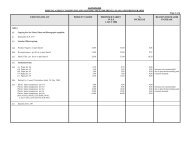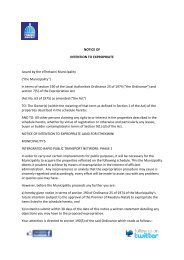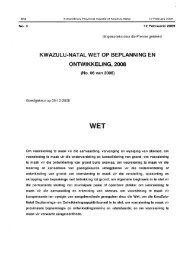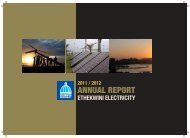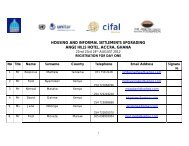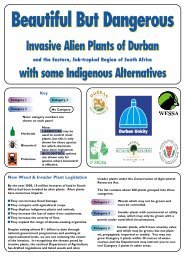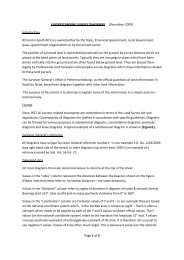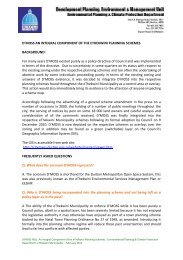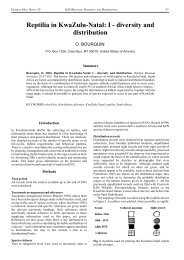Mullin, S. K., Taylor, P. J. & Pillay, N. 2004. Skull size and ... - Durban
Mullin, S. K., Taylor, P. J. & Pillay, N. 2004. Skull size and ... - Durban
Mullin, S. K., Taylor, P. J. & Pillay, N. 2004. Skull size and ... - Durban
Create successful ePaper yourself
Turn your PDF publications into a flip-book with our unique Google optimized e-Paper software.
MULLIN_08 13/08/04 12:45 Page 20<br />
<strong>Mullin</strong> S. K. et al.<br />
karyotypes <strong>and</strong> distinct skull <strong>size</strong>s <strong>and</strong> shapes<br />
from each other. West African material is karyo-<br />
P R O O F<br />
typically stable with 2n = 36, FN = 48 (Matthey<br />
1958; Tranier & Gautun 1979; Granjon et al.<br />
1992; Gautun et al. 1985; Volobouev et al.<br />
2000), although specimens from Niayes, Senegal<br />
have a different FN (44) <strong>and</strong> those from Kangaba,<br />
Mali have 0–3 B chromosomes (Volobouev et al.<br />
2000). Ethiopian specimens are characterised by<br />
different diploid numbers (Harenne forest, 2n = 40;<br />
Baleta forest, 2n = 38), but have the same FN as<br />
the west African forms (Volobouev et al. 2000).<br />
Maddalena et al. (1989) found 2n = 40, FN = 50<br />
in East Africa specimens from Burundi, representing<br />
the sole documented karyotype from east<br />
central Africa. The other known karyotyped<br />
specimens come from South Africa, where two<br />
20<br />
D.i. capensis<br />
D.i. incomtus (KZN)<br />
D. foxi<br />
D.i. incomtus (L/MP)<br />
East African Dasymys<br />
D. rufulus<br />
D.i. griseifrons<br />
Okavango Delta Dasymys<br />
D. montanus<br />
D. nudipes<br />
D.i. longipilosus<br />
1<br />
2<br />
3<br />
B<br />
1<br />
FIG. 7. – CA phenogram of 11 morphologically defined Dasymys groups. Cophenetic correlation coefficient, 0.951. KZN, KwaZulu-Natal<br />
Province; L/MP, Limpopo <strong>and</strong> Mpumalanga Provinces.<br />
karyotypes exist, one from the Limpopo Province<br />
(Klipfontein; 2n = 46) <strong>and</strong> the other from the<br />
KwaZulu-Natal Province (Richards Bay <strong>and</strong><br />
Kamberg; 2n = 38; Gordon 1991; <strong>Mullin</strong> 1999).<br />
Dasymys foxi is restricted to Jos Plateau in Nigeria,<br />
an area historically associated with several different<br />
endemic rodent species (Swanepoel &<br />
Schlitter 1978; Happold 1985, 1987; Hutterer et<br />
al. 1992). In the original description of D. foxi,<br />
Miller (1900) hypothesised that this species was<br />
more similar to East African material than to<br />
D. rufulus from west Africa. Later, Carleton &<br />
Martinez (1991) also suggested that D. foxi has a<br />
skull similar to that of D. incomtus. The results<br />
from our study agree more with Carleton &<br />
Martinez (1991) than Miller (1900) as it seemed<br />
that D. foxi had a closer affinity with material<br />
2<br />
3<br />
MAMMALIA • 2004 • 68 (2)



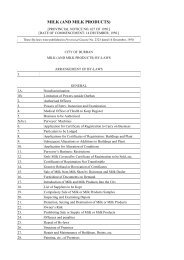
![INK Environmental Sustainability Booklet [19 MB] - Durban](https://img.yumpu.com/22025104/1/190x136/ink-environmental-sustainability-booklet-19-mb-durban.jpg?quality=85)

